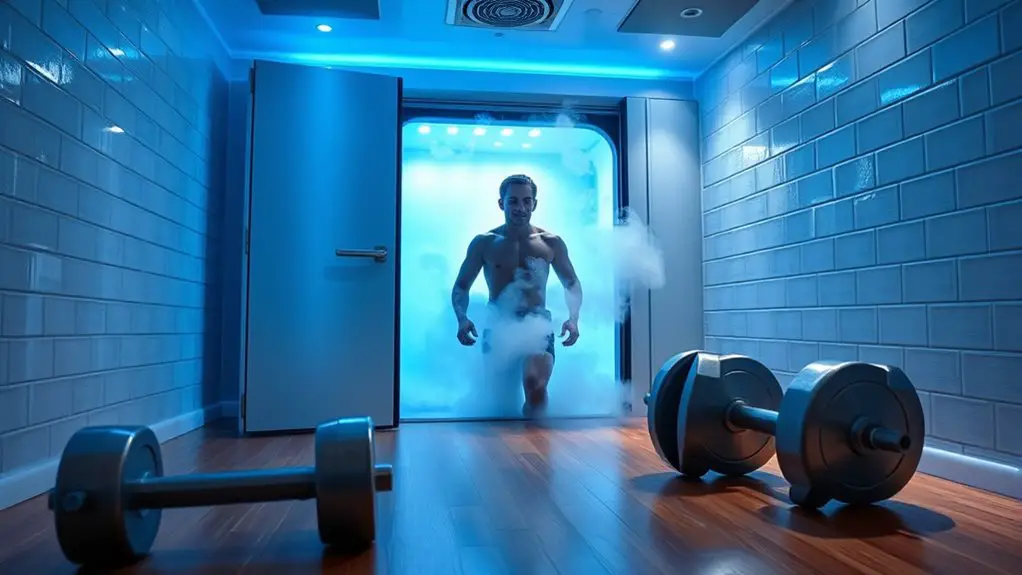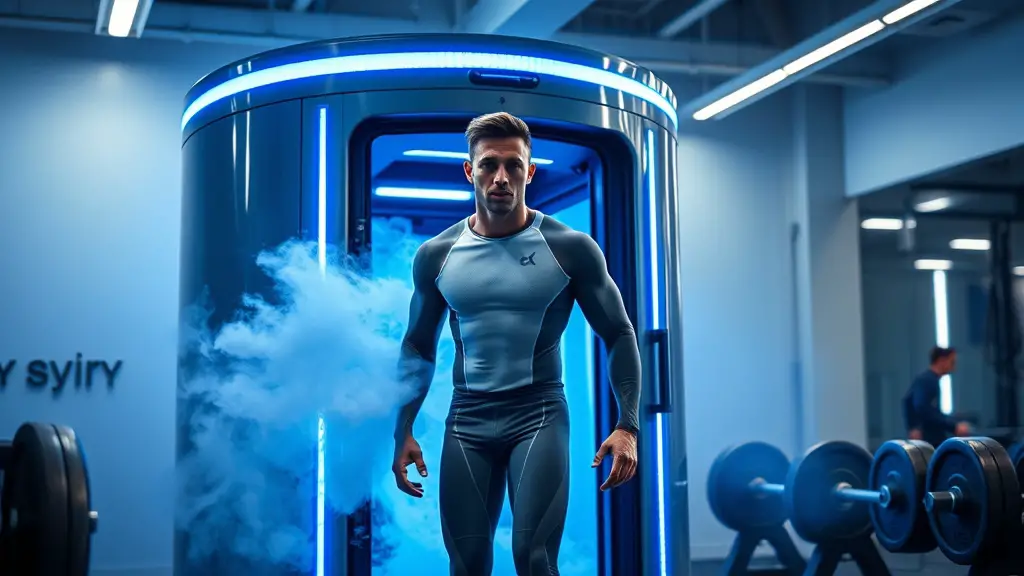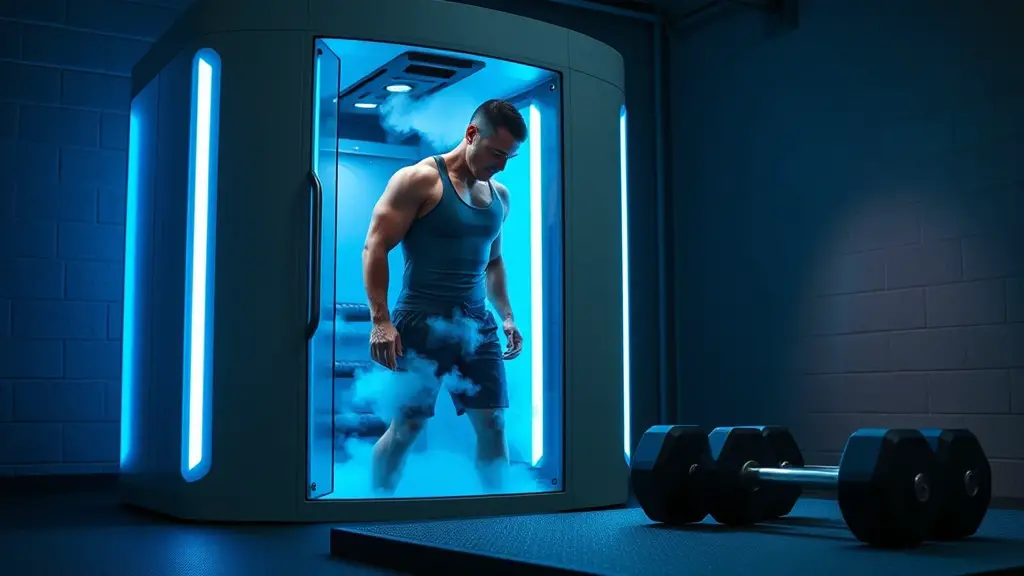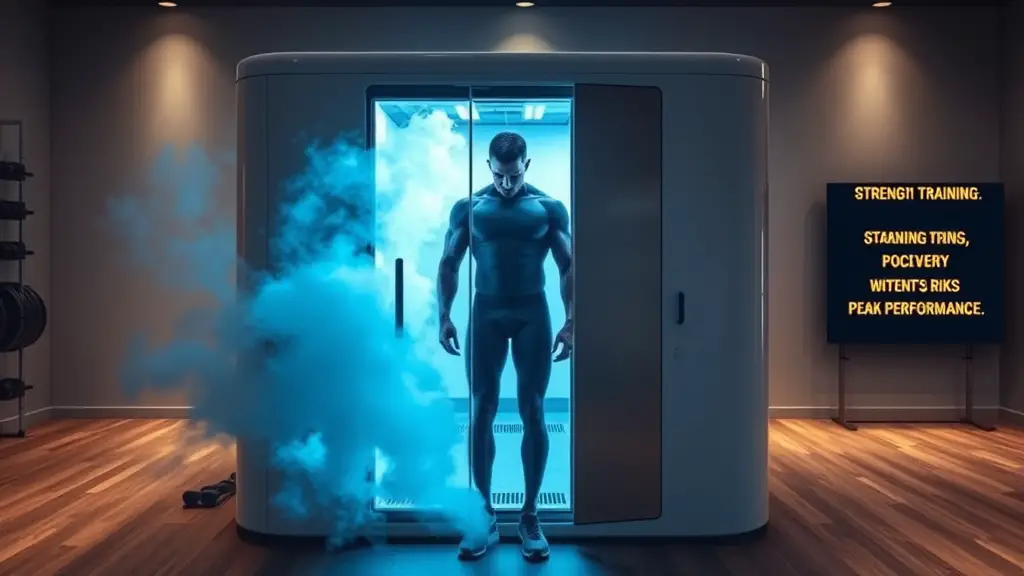The Science Behind Cryotherapy and Strength Training

Cryotherapy utilizes extreme cold to enhance muscle recovery and boost strength training outcomes by mitigating inflammation and reducing muscle soreness. This process constricts blood vessels and decreases metabolic activity, facilitating waste removal and nutrient delivery post-exercise. Studies show it effectively lowers delayed onset muscle soreness (DOMS), helping athletes maintain rigorous training regimens. While beneficial, individual responses and potential risks warrant caution. To better understand how to incorporate this therapy into your routine, further exploration of its applications could prove insightful.
Understanding Cryotherapy: What It Is and How It Works

Although many people associate cryotherapy with quick recovery, its mechanisms extend far beyond mere muscle relief. Originating in the 1970s, cryotherapy history reveals its development as a therapeutic technique aimed at reducing inflammation and pain. You might encounter various cryotherapy techniques, including localized applications like ice packs or advanced systems such as whole-body cryotherapy chambers. These methods utilize extreme cold to induce vasoconstriction, lowering tissue temperature and subsequently reducing metabolic activity.
This process minimizes the release of inflammatory mediators, contributing to faster healing. While you’re likely familiar with cryotherapy’s role in post-exercise recovery, its applications extend to athletic training and rehabilitation. Emerging research indicates that regular exposure to cold can enhance performance by improving overall recovery times, leading to more effective training regimens. Understanding the underlying principles of cryotherapy can empower you to leverage its benefits strategically in your strength training routine.
The Physiological Effects of Cold Exposure on Muscles
Cold exposure can greatly enhance muscle recovery by promoting physiological processes that accelerate healing. It achieves this through mechanisms that reduce inflammation and modulate pain perception, making it an effective strategy for athletes. Understanding these effects can help you optimize your strength training and recovery regimen.
Muscle Recovery Acceleration
When you expose your muscles to cold temperatures, the physiological effects can greatly enhance recovery processes. Cold exposure stimulates vasoconstriction, reducing blood flow to the area, which can subsequently decrease metabolic waste accumulation. This process aids in muscle repair by facilitating a more efficient nutrient delivery system once normal circulation resumes. Research indicates that incorporating cryotherapy into your recovery protocols can lead to a significant decrease in muscle soreness and an accelerated healing timeline. The cold also activates certain cellular responses, such as increased levels of heat shock proteins, which play a vital role in muscle recovery. Overall, integrating cold exposure into your routine can optimize your muscle recovery and improve your performance outcomes.
Inflammation Reduction Mechanisms
As you engage in strength training, understanding how cryotherapy contributes to inflammation reduction can enhance your recovery strategy. Cold exposure effectively modulates inflammation pathways by lowering tissue temperature, which constricts blood vessels and reduces metabolic activity. This process minimizes the release of pro-inflammatory cytokines, thereby attenuating the inflammatory response. Specific cryotherapy protocols can be tailored to optimize these effects, such as applying localized cold packs post-exercise or utilizing whole-body cryotherapy sessions. Research indicates that such interventions can lead to decreased muscle soreness and improved muscle function. By integrating these cryotherapy techniques into your training regimen, you can foster a more efficient recovery process, enabling you to maintain a consistent and effective strength training schedule.
Pain Perception Modulation
The modulation of pain perception through cryotherapy is a significant aspect of its physiological effects on muscles. Cold exposure can elevate pain thresholds by influencing neural pathways involved in pain transmission. Research indicates that cryotherapy induces vasoconstriction, which reduces blood flow and subsequently lowers the metabolic rate of tissues, minimizing inflammatory responses that contribute to pain. Additionally, cold exposure activates the descending pain control pathways, enhancing the body’s natural ability to inhibit pain signals. This action not only alters the perception of pain but also helps in recovery from intense strength training sessions. Consequently, by effectively modulating pain perception, cryotherapy can facilitate more rigorous training regimens and promote overall muscular health.
Reducing Inflammation: How Cryotherapy Affects Recovery
While many athletes seek various methods to enhance recovery, cryotherapy has emerged as a prominent technique for reducing inflammation. This method employs extreme cold to trigger physiological responses that can effectively mitigate inflammation. Research indicates that cryotherapy techniques, such as whole-body cryotherapy and localized cryotherapy, can lead to significant reductions in inflammatory markers, such as cytokines and prostaglandins. By incorporating these techniques into your recovery protocols, you may experience faster healing times and improved performance.
Furthermore, cryotherapy promotes vasoconstriction, which decreases blood flow to inflamed areas, thereby reducing swelling and pain. After the exposure, rewarming induces vasodilation, enhancing nutrient delivery and waste removal in the affected tissues. This cyclical response can optimize your recovery, making cryotherapy an essential tool for athletes aiming to minimize inflammation and enhance overall performance.
Alleviating Muscle Soreness: The Role of Cryotherapy in Post-Workout Recovery

Cryotherapy works by constricting blood vessels and reducing metabolic activity, which can mitigate muscle soreness after intense workouts. Studies indicate that timely application post-exercise enhances recovery by decreasing inflammation and promoting faster muscle repair. Understanding the best timing and mechanisms behind cryotherapy can greatly influence your post-workout recovery strategy.
Mechanism of Cryotherapy
When athletes experience post-workout soreness, understanding the underlying mechanisms of cryotherapy can illuminate its effectiveness in recovery. Cryotherapy applications, particularly cold therapy, induce vasoconstriction, reducing blood flow to inflamed muscles. This process helps minimize swelling and tissue damage. As the body warms post-treatment, a rebound effect occurs, promoting increased blood flow and the delivery of nutrients essential for repair. Additionally, cold therapy can decrease nerve conduction velocity, leading to a temporary reduction in pain perception. Studies suggest that these physiological responses may enhance recovery time and facilitate the healing of micro-tears in muscles. By targeting inflammation and pain mechanisms, cryotherapy serves as a strategic tool for athletes looking to optimize their post-exercise recovery regimen.
Benefits for Muscle Recovery
As muscle soreness often follows intense training sessions, utilizing cryotherapy can considerably enhance recovery outcomes. Research indicates that exposure to cold temperatures reduces inflammation and promotes muscle repair by constricting blood vessels, which minimizes swelling and tissue damage. By incorporating cryotherapy into your recovery protocols, you can effectively alleviate delayed onset muscle soreness (DOMS) and accelerate the healing process. This method encourages the release of endorphins, contributing to pain relief while also improving circulation post-treatment, which aids in nutrient delivery essential for recovery. As a result, integrating cryotherapy into your routine not only supports muscle repair but also optimizes performance in subsequent workouts, ensuring you remain at your peak.
Optimal Timing Post-Workout
Although the timing of cryotherapy application can markedly influence its effectiveness, research suggests that initiating treatment within 24 hours post-workout yields the most substantial benefits for alleviating muscle soreness. Ideal cryotherapy timing is essential; studies indicate that immediate application can reduce inflammation and expedite recovery processes. This window allows the body to benefit from the vasoconstriction effects of cryotherapy, which helps minimize swelling and muscle damage. Additionally, utilizing cryotherapy within this timeframe enhances metabolic waste removal, further promoting post-workout recovery. Consequently, if you’re aiming to mitigate muscle soreness effectively, consider incorporating cryotherapy into your routine right after intense training sessions or within the first day, ensuring you’re maximizing your recovery strategy for peak performance.
Scientific Evidence: Studies Supporting Cryotherapy Benefits

While the debate surrounding cryotherapy’s efficacy continues, numerous studies provide compelling evidence supporting its benefits for strength training and recovery. Research has shown that cryotherapy can reduce muscle soreness and inflammation post-exercise, effectively enhancing recovery times. A meta-analysis indicated that athletes utilizing cryotherapy experienced considerably lower delayed onset muscle soreness (DOMS) compared to those who didn’t.
Moreover, historical uses of cryotherapy in various cultures highlight its long-standing recognition for pain relief and recovery. This lends credibility to modern applications, countering common cryotherapy myths that label it as merely a trend.
In a randomized controlled trial, participants who underwent cryotherapy showcased improved functional performance and muscle strength, reinforcing its role in optimizing training outcomes. Consequently, the scientific community increasingly acknowledges cryotherapy as a viable recovery tool, particularly for strength athletes seeking to maximize their performance potential.
Incorporating Cryotherapy Into Strength Training Regimens
Incorporating cryotherapy into strength training regimens can enhance recovery and performance, especially when strategically timed around training sessions. Research suggests that utilizing cryotherapy benefits athletes by reducing muscle soreness and inflammation post-workout. By exposing your body to cold temperatures, you can promote vasoconstriction, which limits blood flow to inflamed areas, ultimately leading to faster recovery times.
To optimize your strength training, consider scheduling cryotherapy sessions immediately after intense workouts. This timing can help mitigate the delayed onset muscle soreness (DOMS) that often follows strength training. Additionally, consistent use of cryotherapy may improve overall strength gains by enabling you to train harder and more frequently.
Incorporating cryotherapy into your routine isn’t just about recovery; it’s a strategic approach to enhance your performance. As you integrate these sessions, monitor your progress to determine the most effective frequency and timing for your specific training needs.
Potential Risks and Considerations of Cryotherapy for Athletes

Integrating cryotherapy into an athletic training regimen can offer significant benefits, but it’s important to contemplate potential risks and individual responses to cold exposure. While many athletes report reduced soreness and faster recovery, cryotherapy safety must be scrutinized. Individual reactions vary, with some experiencing adverse effects such as skin irritation or frostbite.
Here are key athlete considerations:
| Risk Factor | Consideration |
|---|---|
| Skin Sensitivity | Monitor for any adverse reactions |
| Duration of Exposure | Adhere to recommended time limits |
| Pre-existing Conditions | Consult a healthcare professional |
| Hydration Levels | Guarantee proper hydration prior to sessions |
| Frequency of Treatments | Avoid overuse; balance with recovery needs |
Frequently Asked Questions
How Often Should I Undergo Cryotherapy Sessions for Optimal Results?
To achieve ideal benefits from cryotherapy, it’s generally recommended that you undergo sessions 2 to 3 times a week. This frequency allows your body to recover effectively while maximizing the anti-inflammatory and muscle recovery effects. Individual responses can vary, so it’s important to monitor how you feel and adjust accordingly. Consistency is key, so finding a rhythm that suits your recovery needs will enhance the overall efficacy of the treatment.
Can Cryotherapy Replace Traditional Recovery Methods Like Stretching or Foam Rolling?
Cryotherapy can’t fully replace traditional recovery methods like stretching or foam rolling, but it offers unique benefits. While cryotherapy effectively reduces inflammation and speeds up recovery, it lacks the muscle lengthening and mobility improvements that stretching and foam rolling provide. Integrating cryotherapy with these recovery alternatives can enhance your overall performance and well-being. So, consider using them together for a thorough recovery strategy that maximizes your training outcomes.
Is Cryotherapy Safe for Individuals With Certain Medical Conditions?
Cryotherapy’s safety can vary based on individual medical conditions. There are specific cryotherapy contraindications, such as cardiovascular issues, asthma, or neuropathy, which may increase risks. It’s essential you consult a medical professional before undergoing treatment, especially if you have pre-existing health concerns. They can provide tailored advice and determine if cryotherapy aligns with your health needs. Always prioritize your safety by ensuring informed decisions regarding your recovery methods.
What Should I Wear During a Cryotherapy Session?
When you’re gearing up for a cryotherapy session, think of it as a brisk walk in a winter wonderland. You’ll want to don appropriate attire to guarantee comfort and safety. Lightweight, moisture-wicking clothing is ideal, allowing your body to adjust to the cold while preventing excessive heat loss. Avoid wearing jewelry, as it can amplify the cold sensation. Proper session preparation with fitting attire enhances your experience, letting you enjoy the benefits without distraction.
How Long Do the Effects of Cryotherapy Last After a Session?
The effects of cryotherapy can vary, but typically, you might notice benefits lasting anywhere from a few hours to a couple of days post-session. The cryotherapy duration influences how long these effects persist, with many individuals reporting reduced inflammation and pain relief within this timeframe. It’s crucial to take into account individual responses, as factors like your metabolism and activity level can also affect the duration and intensity of post-session effects.





